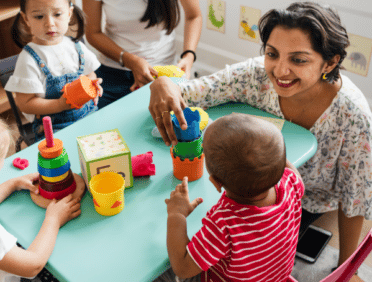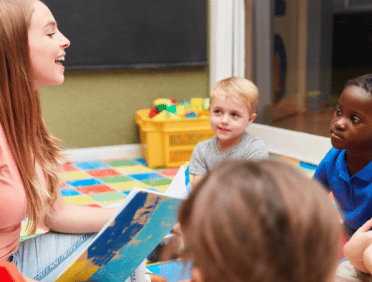Filter by
Anyone who is responsible for the care of children and vulnerable individuals must prioritise their safety. Understanding the principles and practices of safeguarding is crucial for the protection of individuals who may be at risk of injury, regardless of whether one is a parent, teacher, healthcare professional, social worker, or community leader.
Protecting children and vulnerable individuals in the United Kingdom is a collaborative effort that involves a number of different agencies and professionals working together to ensure that these individuals are protected from being abused, neglected, exploited, or otherwise caused harm.
Creating a Safer Environment for Children
Safeguarding and child protection are essential obligations that necessitate diligence, expertise, and a dedication to taking action when necessary. We can establish a safer environment for vulnerable individuals and children in the United Kingdom by maintaining awareness and collaborating. The protection of those who are most vulnerable and the promotion of their well-being are responsibilities that everybody must undertake.
Understanding Safeguarding
Organisations and individuals are required to adhere to safeguarding protocols and measures in order to safeguard the health, well-being, and human rights of individuals, with a particular emphasis on children and vulnerable adults.
Preventing abuse and neglect is the primary objective, which guarantees that all individuals, irrespective of their age or ability, can reside in a secure environment without fear of injury.
Key Elements of Safeguarding
- Prevention: ensuring that all possible risks are identified and mitigated to prevent harm.
- Protection: taking immediate and effective action when concerns are raised about potential abuse or neglect.
- Support: providing ongoing care and assistance to those affected by abuse, ensuring their recovery and well-being.
- Empowerment: encouraging individuals to understand their rights and make informed decisions about their safety and well-being.
Child Protection
One particular aspect of safeguarding is child protection, which is dedicated to the prevention and mitigation of damage or the risk of harm to children. Identifying children who are at risk, taking the necessary steps to safeguard them, and providing assistance to their families are all part of this process.
Child protection in the United Kingdom is regulated by a variety of laws and regulations, such as the Children Act 1989 and 2004, which establish the legal framework for the protection of children.
Signs of Abuse and Neglect
Professionals and carers should be aware of the signs of abuse and neglect, which may include:
- Unexplained injuries or frequent accidents
- Sudden changes in behaviour or school performance
- Fearfulness or withdrawal from social interactions
- Poor hygiene, malnutrition, or untreated medical issues
- Reluctance to go home or fear of certain individuals
Reporting Concerns
Reporting suspected child abuse or neglect is your responsibility. The National Society for the Prevention of Cruelty to Children (NSPCC) helpline, the police, or the children’s services of the local authority are all options for achieving this goal in the United Kingdom. Protective measures for the child can be initiated, and additional injury can be prevented by timely reporting.
Safeguarding vulnerable adults
Protecting vulnerable adults necessitates safeguarding those who may be at risk as a result of age, disability, illness, or other factors. Adults who are vulnerable to abuse may experience neglect, as well as physical, emotional, financial, or sexual abuse.
Recognising Abuse in Vulnerable Adults
Abuse in vulnerable adults may not always be as obvious as in children, but there are still signs to watch for:
- Unexplained financial transactions or sudden loss of money
- Bruises, sores, or injuries that are not explained
- A sudden change in living conditions, such as poor hygiene or unclean living spaces
- Withdrawal, depression, or unexplained fearfulness
- Lack of access to medical care or other necessary services
Steps to Take
Report your concerns to the local authority’s adult safeguarding team or the police if you suspect that a vulnerable adult is being abused or neglected. During any intervention, it is crucial to demonstrate respect for the individual’s privacy and dignity.
The Role of Professionals and Agencies
Multiple agencies and professionals must collaborate to ensure effective safeguarding. Healthcare providers, educational institutions, law enforcement, and local authorities must collaborate to assess risks, share information, and implement coordinated measures to safeguard vulnerable populations.
Training and Awareness
Every professional who is involved in the safeguarding process must get ongoing training and awareness. Having a comprehensive understanding of the most recent legislative requirements, best practices, and local regulations ensures that all individuals are ready to appropriately respond to concerns regarding the protection of individuals.
Frequently Asked Questions (FAQs)
Safeguarding is the term used to describe the measures implemented to safeguard the health, well-being, and human rights of individuals, with a particular emphasis on children and vulnerable adults, to guarantee that they are not subjected to neglect, abuse, or injury.
Since it ensures the safety of all people in the United Kingdom, regardless of their age or country of origin, it is of the utmost significance in that country. Working together to prevent abuse and intervene when necessary, safeguarding is a collective responsibility that involves individuals, organisations, and government agencies.
Safeguarding is ingrained in a variety of laws and regulations in the United Kingdom with the goal of ensuring that a consistent and effective approach is taken across all sectors. The framework for safeguarding practices is established by the Care Act 2014, the Children Act 1989, and the Safeguarding Vulnerable Groups Act 2006.
Under these laws, it is mandatory for all organisations that work with children or vulnerable individuals to have comprehensive safeguarding policies.
Safeguarding is also crucial because it prevents abuse before it occurs, thereby promoting the welfare of children and vulnerable adults. This proactive approach involves informing individuals and communities about the indicators of abuse and the appropriate course of action to take in the event that they suspect injury.
Not only is it a legal obligation, but it is also a moral obligation to protect the most vulnerable members of society by providing them with protection.
Child protection in the United Kingdom is founded on a number of fundamental principles that are designed to protect children from damage. In any decision-making process, the child’s welfare is the primary consideration, as guaranteed by these principles.
One of the most important goals is to protect children from harm, make sure that their voices are heard, and fulfil the requirements that they have presented.
Prioritising the child’s welfare is the initial fundamental principle. Local authorities are required to promote and protect the welfare of children in their jurisdiction, as stipulated in the Children Act 1989. This implies that the safety and well-being of the infant should be the primary consideration in all decision-making.
Another principle is that children have the right to be heard and to have their opinions taken into account in decisions that affect them. This principle acknowledges the significance of involving children in conversations about their lives, thereby fostering a sense of respect and appreciation for them.
The prevention of potential hazards is given a significant amount of importance, and various agencies and organisations are working together to identify and eliminate potential dangers before they can cause harm.
Numerous legal frameworks regulate safeguarding and child protection in the United Kingdom, guaranteeing a comprehensive approach to safeguarding vulnerable individuals. Outlining the duties and responsibilities of the various agencies involved in child protection, these frameworks provide the statutory basis for safeguarding practices.
Laws such as the Children Act 1989 and 2004 are essential pieces of legislation that establish the legal framework for the care and protection of children. Local authorities are obligated to protect and advance the welfare of minors in their jurisdiction under the 1989 Act. The Every Child Matters framework, which underscores the significance of interagency cooperation and integrated services, was implemented by the 2004 Act.
The Care Act of 2014 is absolutely necessary for the protection of adults who are vulnerable. Local authorities are obligated to ensure the well-being of individuals who are at risk of being neglected or abused, and this document outlines their responsibilities accordingly.
The Safeguarding Vulnerable Groups Act of 2006 further strengthens these frameworks by preventing individuals who are not suitable for working with children and vulnerable adults. This is accomplished through the establishment of the Disclosure and Barring Service (DBS).
The protection of vulnerable adults and children in the United Kingdom is a shared responsibility that necessitates the cooperation of government bodies, organisations, and individuals. The effective implementation of safeguarding measures and the protection of vulnerable individuals from damage are the responsibilities of each entity.
Education, healthcare, social services, and law enforcement professionals are legally obligated to protect and advance the welfare of vulnerable adults and children. As part of this obligation, they are obligated to remain vigilant in recognising indicators of neglect or abuse and to take the necessary steps when concerns arise.
Educators, medical professionals, and social workers, for example, are required to report any suspicions of injury to the appropriate authorities by law.
Local authorities are significant in the coordination of safeguarding initiatives and the facilitation of effective collaboration among agencies. They are legally obligated to investigate suspected abuse cases and offer assistance to individuals who are at risk.
Safeguarding is an endeavour that involves the entire community, and it is the responsibility of the general public to report any questions or concerns they may have regarding the well-being of a child or an adult who is vulnerable.
Safeguarding Adults Boards (SABs) and Local Safeguarding Children Boards (LSCBs) are essential in the coordination and supervision of safeguarding activities in their respective communities. These committees convene representatives from local authorities, health services, the police, and other pertinent organisations to guarantee a collaborative approach to safeguarding.
Development and implementation of local safeguarding policies and procedures are the primary responsibilities of LSCBs and SABs. They guarantee that all organisations engaged in safeguarding are operating in unison, exchanging information, and responding appropriately to allegations of neglect or abuse.
These committees are responsible for monitoring and evaluating the effectiveness of safeguarding practices in their respective jurisdictions according to their responsibilities.
Another significant function of safeguarding boards is to increase community awareness and comprehension of safeguarding concerns. They offer training, guidance, and resources to the public and professionals to guarantee that all individuals are aware of how to safeguard vulnerable adults and children.
Committees like these are absolutely necessary for protecting those who are vulnerable and preventing harm because they foster an atmosphere of collaboration and vigilance.
Identifying the indicators of neglect or abuse in children and vulnerable individuals is crucial for ensuring their safety. Dependent on the individual’s age and circumstances, these indicators may differ depending on the form of abuse—physical, emotional, sexual, or neglect.
Common indicators of physical maltreatment include fractures, burns, or bruises that are not explicable. There are also instances in which a juvenile or vulnerable adult may demonstrate behavioural changes, including aggression, fear, or withdrawal.
Emotional abuse may be identified by low self-esteem, anxiety, or depression, whereas sexual abuse may be indicated by inappropriate sexual behaviour or knowledge that exceeds their age.
The most prevalent form of abuse, neglect, frequently manifests as malnutrition, poor hygiene, or unattended medical requirements. Developmental delays or a lack of emotional attachment may also be the consequence of neglect in both children and vulnerable individuals.
Even though these indicators are not always conclusive evidence of abuse, they should serve as an indication of further investigation and apprehension. The fact that this is the case is something that must be kept in mind at all times.
If you have reason to believe that a child or vulnerable adult is being abused or neglected, it is imperative that you behave responsibly and promptly. The first step, in the event that it is required, is to ensure the immediate safety of the individual by removing them from any potential dangers that may be present.
Avoid directly confronting the person who is suspected of violating the rules, as this could potentially make the situation even more dire.
The local safeguarding team, social services, or police are the appropriate authorities to whom you should disclose your concerns. Every local authority in the United Kingdom has a defined safeguarding team that is capable of offering guidance and implementing the necessary measures. Documentation of your concerns is also crucial, including the actions you have taken and any indications of abuse or neglect.
Despite the importance of confidentiality, it should never serve as an impediment to reporting concerns. Individuals who report suspected abuse in good faith are safeguarded by the law, even if the allegations are ultimately verified as unfounded.
Through the act of reporting your concerns, you are playing a significant part in protecting vulnerable individuals from experiencing an increase in instances of injury.
Safeguarding children is a critical responsibility of schools, as they are frequently the first to detect indications of neglect or abuse. Schools are legally obligated to safeguard children from injury and to advance their well-being in accordance with UK law.
Keeping Children Safe in Education (KCSIE) statutory guidance delineates the safeguarding procedures that all schools are required to adhere to, outlining this responsibility.
One of the primary responsibilities of schools is to establish a secure and nurturing environment in which children feel appreciated and protected. A designated safeguarding lead (DSL) is required in schools with the responsibility of coordinating safeguarding efforts, which includes training staff to identify and respond to indicators of abuse.
The establishment of clear policies and procedures for the management and reporting of concerns regarding the protection of students is another requirement that schools must fulfil.
Schools collaborate closely with local authorities, social services, and other organisations to guarantee a unified approach to safeguarding. In addition, they are accountable for instructing students on the importance of maintaining their safety, both online and offline.
This includes assisting them in recognising potential dangers and determining how to seek assistance in the event that it is required.
The UK government provides legislative, financial, and advisory support to the community in order to safeguard vulnerable individuals. The Department of Health and Social Care and the Department for Education (DfE) are among the government departments that are responsible for the development and enforcement of safeguarding policies.
The government provides statutory guidance, such as “Care and Support Statutory Guidance” and “Working Together to Safeguard Children,” to support safeguarding. These guidelines delineate the responsibilities of local authorities, health services, and other agencies.
These documents establish a framework for safeguarding practices throughout the United Kingdom, thereby guaranteeing their consistency and efficacy.
The government also provides funding to support local safeguarding initiatives and training programs. These funds are instrumental in guaranteeing that professionals possess the requisite resources and expertise to safeguard vulnerable individuals and children.
The government oversees and regulates safeguarding practices through organisations such as the Care Quality Commission (CQC) and Ofsted, guaranteeing that standards are met and that improvements are implemented as required.
Professionals employed in safeguarding positions are mandated to participate in particular training programs to ensure that they possess the requisite knowledge and abilities to safeguard vulnerable individuals. The purpose of this training is to guarantee that professionals are capable of recognising, addressing, and preventing neglect or abuse.
The degree of training necessary is contingent upon the position. For instance, it is mandatory for all personnel employed in educational institutions, healthcare facilities, and social services to undergo fundamental safeguarding training.
This training encompasses the legal obligations of personnel, the identification of signs of abuse, and the reporting procedures. This training is typically updated annually to reflect changes in legislation and best practices.
A higher level of training is necessary for individuals who are designated as safeguarding officers or designated safeguarding leads (DSLs). This encompasses a comprehensive understanding of safeguarding legislation, interagency collaboration, and the efficient management of intricate safeguarding cases.
Consistent professional development (CPD) is also crucial, with professionals being encouraged to participate in seminars, conferences, and training sessions to remain informed about the most recent advancements in safeguarding.
The process of reporting a safeguarding concern in the United Kingdom is straightforward and is intended to ensure the protection of vulnerable individuals as soon as possible.
Please do not hesitate to contact the appropriate public authorities if you have any reason to believe that a child or an adult who is vulnerable is in danger.
The safeguarding team of the local authority is typically the initial point of contact, and they are capable of offering guidance and taking proper action if required. The contact details for your local safeguarding team can be located on the website of your local council.
The police should be contacted by dialling 999 if you are of the opinion that an individual is in imminent danger.
The National Society for the Prevention of Cruelty to Children (NSPCC) also offers a helpline through which individuals may report any concerns. They have the ability to offer guidance and refer individuals to their respective local safeguarding teams.
A report should contain as much information as possible, including the circumstances surrounding the individual, the suspected instances of abuse or neglect, and any actions that have been taken by the individual.
The investigation might be completed more quickly and easily if you provide your personal information. There is a possibility that you can submit reports without disclosing your identity.
Failure to notify suspected abuse or neglect can result in severe legal and ethical repercussions. Professionals who work with children or vulnerable adults in the United Kingdom are required to disclose any concerns regarding their welfare.
Neglecting to do so may lead to legal repercussions, disciplinary action, and, most importantly, additional damage to the individual who is at risk.
Failure to disclose concerns may result in disciplinary action from the employer or regulatory body for professionals. This may involve suspension, dismissal, or loss of professional registration.
The Serious Crime Act 2015 establishes that neglecting to safeguard a child or vulnerable adult from the threat of severe injury is a criminal offence that may lead to imprisonment.
From an ethical standpoint, neglecting to report concerns undermines the confidence that professionals have in their ability to safeguard vulnerable individuals. This can result in the collapse of safeguarding systems, which could potentially enable the continuation of abuse or neglect.
When it comes to protecting those who are in danger, it is essential to both report any concerns that may arise and make certain that the appropriate actions are taken.
The General Data Protection Regulation (GDPR) establishes stringent regulations regarding the management of personal data, which has an impact on the UK’s safeguarding practices. Although GDPR underscores the significance of safeguarding the privacy of individuals’ data, it does not prohibit the exchange of information when it is necessary to safeguard a juvenile or vulnerable adult.
Under GDPR, organisations are required to guarantee that any personal data they accumulate is processed in a manner that is lawful, equitable, and transparent. Consequently, it is imperative that records are protected with the utmost care, ensuring that only pertinent information is disclosed to those who require it.
GDPR acknowledges that the safety of individuals is of greater importance than data protection, and consent is not required for the sharing of information if it is necessary to prevent damage.
Organisations that are engaged in safeguarding must establish explicit policies and procedures to ensure that their safeguarding obligations are balanced with their data protection obligations.
This includes the provision of staff training in both GDPR compliance and safeguarding practices, thereby enabling them to comprehend the appropriate timing and dissemination of information.
The overarching objective of safeguarding individuals from danger is shared by safeguarding children and safeguarding vulnerable adults; however, the legal frameworks and approaches they employ are distinct. Understanding these distinctions is essential for the effective protection of both populations.
Safeguarding minors entails the prevention of abuse, neglect, and exploitation of individuals under the age of 18. The Children Act 1989 and 2004 are the primary legal frameworks that regulate the protection of children.
These acts impose specific responsibilities on local authorities, schools, and other organisations to ensure the well-being of children. Safeguarding children’s rights and fostering their development in a secure environment are the primary objectives.
On the other hand, safeguarding vulnerable adults is concerned with the protection of individuals over the age of 18 who are at risk due to factors such as age, disability, mental health issues, or illness. The primary legislation regulating the safeguarding of adults is the Care Act 2014, which underscores the significance of individual choice and empowerment.
Although the principles of safeguarding are similar, the approach for vulnerable individuals frequently entails evaluating their ability to make decisions and ensuring that their wishes are honoured.
Organisations can guarantee that they are in compliance with safeguarding legislation by undertaking comprehensive risk assessments, implementing robust policies, and offering consistent training. There is more to compliance than simply adhering to legal obligations; it involves cultivating an organisational culture that prioritises safety and vigilance.
The first step is to develop and implement comprehensive safeguarding policies that align with UK legislation, such as the Children Act 1989, the Care Act 2014, and the Safeguarding Vulnerable Groups Act 2006. These policies should outline the procedures for reporting concerns, conducting background checks on staff, and ensuring that all individuals who come into contact with children or vulnerable adults are appropriately trained.
Regular training is essential for ensuring that all staff members understand their safeguarding responsibilities. This training should cover the signs of abuse, how to report concerns, and the specific legal obligations that apply to their role.
Organisations should also conduct regular audits and reviews of their safeguarding practices to identify any areas for improvement and ensure ongoing compliance.
Children and vulnerable adults who have experienced abuse are entitled to a range of support services designed to help them recover and rebuild their lives. These services are provided by local authorities, healthcare providers, and specialised charities, all working together to ensure that individuals receive the care and support they need.
One of the primary sources of support is counselling and mental health services. These services provide a safe space for individuals to talk about their experiences and receive professional help in dealing with the trauma of abuse.
For children, Child and Adolescent Mental Health Services (CAMHS) offer specialised support tailored to their needs.
Support for mental health, assistance with practical matters such as housing, advice from legal professionals, and financial assistance may also be among the options available. Local authorities have a duty to provide or arrange for the provision of services to meet the needs of children and vulnerable adults who have experienced abuse.
Charities such as the NSPCC and Victim Support also offer a range of services, including helplines, advocacy, and recovery programs, to help individuals navigate their recovery journey.
Becoming a certified safeguarding officer in the UK requires a combination of relevant experience, training, and a commitment to ongoing professional development. The position of safeguarding officer is one that carries a significant amount of responsibility because of the critical role they play in protecting members of the vulnerable population.
The first step towards becoming a safeguarding officer is to gain experience in a role that involves working with children or vulnerable adults, such as teaching, social work, or healthcare. This experience provides the foundation of knowledge and understanding needed to take on the safeguarding responsibilities effectively.
Next, you will need to complete formal safeguarding training, which is available through various accredited providers. This training should cover the legal framework for safeguarding, how to identify and respond to abuse, and the role of the safeguarding officer. Many organisations also offer specific courses for those looking to become Designated Safeguarding Leads (DSLs) or Safeguarding Officers.
Once you have completed the necessary training, you can apply for certification through a recognised body, such as the NSPCC or the Safeguarding and Protecting Children Certification.
Ofsted and the Care Quality Commission (CQC) are two key regulatory bodies in the UK that play a crucial role in safeguarding. Both organisations are responsible for inspecting and regulating services to ensure that they meet the necessary safeguarding standards and protect vulnerable individuals from harm.
Ofsted is responsible for inspecting services that care for and educate children and young people, including schools, early years settings, and children’s social care services. During inspections, Ofsted assesses how well these services protect children from harm, including the effectiveness of their safeguarding policies, staff training, and reporting procedures.
Ofsted’s reports highlight areas of good practice and identify where improvements are needed to ensure the safety and well-being of children.
The CQC, on the other hand, regulates health and social care services for adults, including hospitals, care homes, and domiciliary care agencies. The CQC’s role in safeguarding involves ensuring that these services provide safe, effective, and compassionate care that protects adults from abuse and neglect.
The CQC conducts inspections, investigates complaints, and takes enforcement action where necessary to ensure compliance with safeguarding regulations.
Regulations governing safeguarding in the United Kingdom are continuously updated to take into account new scientific findings, societal shifts, and challenges. Keeping up to date with these changes is crucial for anyone involved in safeguarding, as it ensures that practices remain effective and compliant with the latest legal requirements.
One of the recent updates includes the introduction of the Domestic Abuse Act 2021, which provides greater protection for victims of domestic abuse, including children. The Act recognises children as victims in their own right if they see, hear, or experience the effects of domestic abuse, which has significant implications for safeguarding practices.
Another important update is the revised Keeping Children Safe in Education (KCSIE) guidance, which was updated in September 2023. This guidance includes new requirements for schools to have robust procedures for dealing with sexual harassment, online safety, and mental health issues among students.
The importance of listening to children and taking their concerns seriously is another point that is emphasised by this policy.
Organisations must review and update their safeguarding policies and procedures regularly to reflect these changes. Staying informed about the latest safeguarding regulations ensures that children and vulnerable adults continue to receive the highest levels of protection.
Given the increasing amount of time that children spend on the internet, it is becoming an increasingly important aspect of safeguarding to ensure the safety of children while they are using the internet.
Parents and guardians play a crucial role in protecting their children from online risks, including exposure to inappropriate content, cyberbullying, and online predators.
One of the most effective ways to ensure online safety is through open communication. Parents should talk to their children regularly about their online activities, who they are interacting with, and the potential risks they may encounter.
Encouraging children to share their online experiences and concerns can help parents identify any issues early and provide guidance on safe internet use.
Another important step is setting up parental controls on devices and using software that can filter or block inappropriate content. Parents should also ensure that privacy settings are activated on social media platforms to limit who can see their child’s information and posts.
Children need to be taught the significance of protecting the privacy of their personal information and how to identify suspicious behaviour when they are using the internet.
Parents have a responsibility to remain up-to-date on the most recent developments, applications, and platforms that their children may be using on the internet. Understanding the digital landscape enables parents to provide relevant advice and take proactive measures to keep their children safe.
Parents can assist their children in safely navigating the online world by being involved and vigilant in their children’s internet use.















